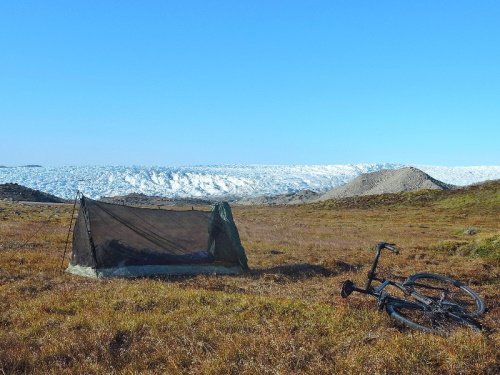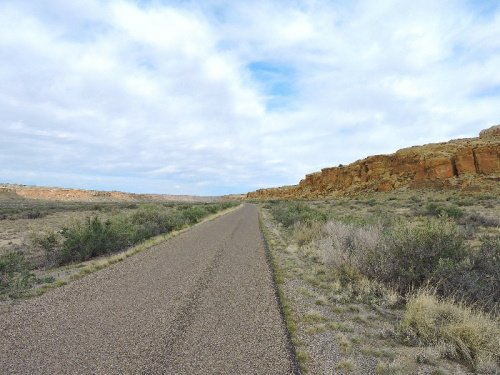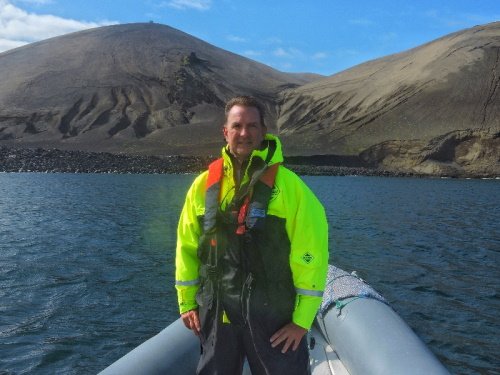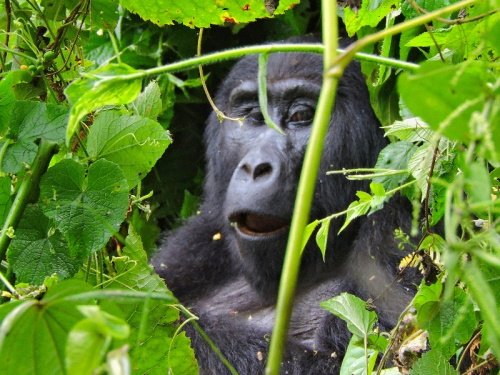Remember that stunning photo of Burkhan Khaldun ? Or that first review of Thimlich Ohinga ? They were made by Michael Ayers , who has just finished his second world tour on a bicycle. A trip that took place between 2019 and 2022, where he visited 124 new Sites, bringing his total to over 300. For a total of 1,121 days, he visited one WHS every 8.6 days. Discounting the 317 days being inactive for Covid procedures, general travel disruptions, or convalescence, it was more like one every 6.2 days. He’s also a keen birder and managed to add 1,152 new species to his worldwide Life List. Meet Michael below, while he shares his experiences as a WH Traveller on a bicycle.

How do you decide on the itinerary for such a long tour?
I have always been a cartophile, and have continuously studied geography as a hobby, so for me working out the itinerary is almost as enjoyable as the travel itself. I have happily spent many hours looking at maps, deciding which parts of the world would be most compelling to visit. Technology has, of course, had an effect on that process, and for this tour I accomplished in days, what took weeks previously, which may, or may not, be a good thing. There are a few other considerations, specific to cycling, that also require attention when devising an itinerary. One of those involves trying to create a route where the cycling conditions would be at least tolerable for most of the time. This is becoming increasingly difficult as many parts of the world continue to downgrade their road networks by bringing them to “modern” standards. Another challenge is trying to ensure that you will always be in a particular region at its best time of the year, with regard to the summer/winter, or wet/dry seasons. For a very long tour, achieving that completely is a practical impossibility.
Do you especially target WHS that few other people have visited?
I don’t think I have ever said, “What is the most remote place I can go to?” But it would be dishonest for me to state that I didn’t receive a certain amount of satisfaction when visiting places that most mainstream tourists rarely get to see. It is also true that many remote WHSs have as their primary OUV the types of qualities that most interest me: beautiful forests, the ruins of ancient cities, rock art, interesting geology, and unique flora and fauna, for example. Additionally, when on a cycling tour that encompasses a large portion of a continent it is likely that any route you may come up with will take you fairly close to at least one remote Site, so why not adjust the route a little to permit a visit? Sites like Australian Fossil Mammal (Riversleigh) and Serra da Capivara , were examples of both of those factors for me.

Your trip coincided with the Covid-years of 2020-2021. What has been the impact on the trip?
I am sure that in the spring of 2020 people were wondering why I did not abandon the tour once the closures started occurring. As you might suspect, the decision whether, or not, to do that was more complex than it might have appeared. For me, the World2 Tour was an intermediate point in the process of permanently relocating my home from the USA to a much more distant part of the world. Therefore, in 2019 I let my old house go and put all of my belongings into a shipping container for storage. Had I decided to return home in March 2020, my first task would have been to find a new place to live, quite challenging considering that the US was, at the time, one of the worst places to be regarding Covid. Additionally, the country I was intending to move to had quickly closed its borders, which remained that way for over two years, so I could not go there. So the only realistic option was to keep moving as best as possible, until the circumstances improved.
The most depressing period was the first six-week “lite” lockdown I spent in Berlin, where every day I would cross a number of expected WHS visits off of my future plans, while realizing that I might never have another opportunity to make those visits (eventually I did get a few of those back, but usually at great expense.) After a while, I was able to move around to wherever was letting people in at the time, and I generally became numb to the continual disruptions and changes in plans. Those included, but were not limited to, two strict 14-day quarantines, several self-isolation periods, being denied boarding at airline check-in counters five times, being denied entry at an airport after disembarking for visa issues, and a total of 46 Covid tests (32 PCR/14 Antigen, costs between $0 and $160, for a total of $2,775,) all negative, of course.
What were the WHS during this trip that have impressed you most?
There were definitely many that presented their OUV very well, however, for me, the most memorable are those visits where all the important factors, including weather, lack of crowds, cycling conditions, and the characteristics of the Site itself, all came together perfectly to make for an extraordinary experience, and I will actually give you four examples:
Chacho Culture . There are some WHSs where having your own bicycle is a tremendous advantage, Angkor, for example. This Site was another, and once the tiresome dirt road between the highway and the Park entrance was behind me, everything was perfect. On a beautiful spring day, with only a few other visitors around, cycling along the loop road, with numerous exceptional ruins and rock art panels spaced out nicely along the way, was simply glorious.
Aasivissuit-Nipisat . This was a visit that could have gone wrong in so many ways. Flight on a small aircraft from Nuuk to Kangerlussuaq; reassembly of the bike at the airport; cycling to the end of the gravel road of unknown quality; spending the night there; cycling back the next morning; disassembling and repacking the bike at the airport; another small flight to Illulisat in the afternoon. Fortunately, everything worked perfectly. The weather was spectacular, I saw musk-ox, the scenery was incredible, and camping under the midnight Sun within sight of the Greenland Ice Sheet was an unforgettable experience.
Bwindi . The dirt road that climbs up the mountain to the Park was not as difficult as I expected, and the cool weather of Uganda got even more exhilarating as the altitude increased. Best of all, on the day of my tracking, when I was the only visitor present, the Gorillas chose to settle down for their day at a particularly convenient location. Additionally, to help restart tourism in late 2020, Uganda had temporarily reduced the tracking fee to $400, down from $700 (the only noteworthy covid-related discount I ever had.) On my first long tour, at one point I found myself at the tracking base in Rwanda, but foolishly talked myself out of going to see the Gorillas, and I was very relieved to have finally been able to correct that major error.
Surtsey . If you had only asked me for only one Site, this would have been my choice, even though the actual visit was made by boat, not by bike. In addition to the uncommon-destination effect mentioned above, this was another case of both seemingly unlikely scheduling and weather coming through at the last minute to make a visit possible, with a destination that had long been a personal aspiration for me. I was very pleased to learn that a few other community members have been able to get there since then. The cost for that visit was 2.5 times what I told myself I would be willing to spend, but when the time came I found myself agreeing without hesitation, and I am so glad that I did, it was a near-perfect day!

Which were the WHS you visited (on this or the previous tour), which were the best for birding?
Not surprisingly, all of my recommendations will be Sites in the tropics. Most people will immediately think of rainforests. While there are always many great birds in that habitat, tropical forests are notoriously difficult places to see birds well, even for birders who are much more experienced than I am. Central Suriname turned out well for me this time, but Central Amazon was rather disappointing. I tend to prefer areas where the environment is a little more open. Pantanal was really excellent, as was Kakadu for the unique Australian birds. I was in Korea at exactly the wrong time of year for migratory birds on the mudflats, so I didn’t even try there. However, my personal favorites are the Sites on the East African savannas, Kenya Lakes , Serengeti , and Ngorongoro , for example. Not only are there many beautiful and unusual bird species there, but they are often much easier to see, even around the Lodges, or nearby towns and cities. The drawback is that you probably won’t be able to do that independently, but on the plus side there is always the chance that you might get eaten by a Leopard!
Your way of travelling also is a tribute to slow travel. Some people would go crazy about what happened to you when trying to visit the Rock Islands of Palau…
Slow travel is definitely the best travel. And if you are going to be slow, Palau is an excellent place for that. The country was my first destination after leaving my cursed stay on Guam [ Michael had a serious cycling accident here, ed. ], and I intended to be there for a while, to begin my rehab and, of course, enjoy the Rock Islands . After about two weeks, I was feeling mostly ready to organize my visit to the Site, but it was not going to be simple. Only relatively few tourists had made it back to Palau at the time, but all of the tour operators would only run tours with at least four people, so no one was going to the Islands any time soon. I had just started to look around for a more costly private tour, when another delay became apparent. The chief of Koror State, Ibedul Yutaka Gibbons, had just passed away while receiving medical treatment in Taiwan.
Palauan tradition required that there would be a period of mourning, with all official offices, services and many businesses on Koror closed until after the official funeral, and this included the Rock Islands. Apparently, this usually lasts for a few weeks, but this time it would be a little longer, to allow time for the Chief to be brought back from Taiwan, and no one could say for sure when everything would be open again. I was supportive of the idea of keeping up the tradition, especially since I learned that Chief Gibbons seemed to have been an admirable public servant, who was one of the officials who had previously stood up to the U.S. Navy by prohibiting nuclear warships from operating in Palauan waters. The local tourism industry was more distressed, however, since they had just started up again after being shut down for over eighteen months.
In the end, the closure lasted for about four weeks. The ferry I took from Koror to Peleliu Island actually passes right through the core zone of the Site, and it provided nice views, so in the worst case I probably would have counted that as a visit, but I still wanted a more proper experience. During my final days in the country the Site was open again, but bad weather prevented small boats from going there up until the very last day, right before my midnight flight out. Six weeks is a personal record for the length of time required to visit a Site, but I was definitely happy to finally see that beautiful WHS up close.

Finally, tells us what it is about dogs and bicycles?
Free-roaming dogs have been a contentious topic in the cycling community for decades. However, from experience, I can say that this is primarily a problem in the Americas, Europe, and a few other places, where dogs are more likely to be “purebred,” a situation that has caused many of them to go insane. In other parts of the world, the de-evolving mutts you are more likely to encounter are usually much less aggressive. It has long been my strategy when unfriendly dogs are around to simply try to outrun them, which usually works. One time when it didn’t was during the early weeks if this tour, as I was riding across the US state of New Mexico. For the first time in my life, one of those snarling beasts actually got its teeth briefly on my left ankle, drawing blood in the process.
A few days later, I was making my way uphill to get to the Taos Pueblo Site. The highway leading to the town of Taos is deficient in a typically American way, being too narrow for the amount of high-speed traffic it carries, so I was already feeling quite stressed. There is only one smaller road that covers the final few kilometers to the Pueblo and I was dismayed to see a sign there that read, “Walking Prohibited, Bicycling Prohibited.” Of course, I thought, “That’s outrageous!” and kept on riding to the Site, an act for which I was politely scolded by the Puebloan staff when I arrived. Later, I learned that that policy was enacted because the Puebloans in the area are worried that someone might get bitten by one of the mean feral dogs that live around that road. I wanted to say something like, “I’ve already had a dog bite in New Mexico, let me ride through!” but mainly I just thought that perhaps finding a nicer home for those dogs might be a better solution.




